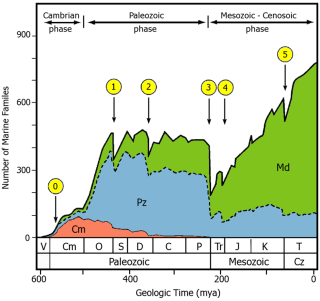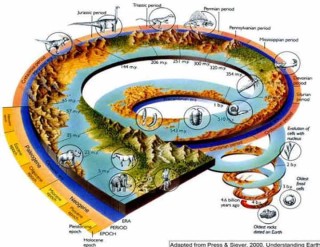Climate and paleoclimate

Climate and paleoclimate are being investigated (including those related to mass extinctions) over short & long timescales from differences in the abundances & stable isotope ratios of biomarkers preserved in petroleum & the rock record. Some of the most significant pulses of evolution throughout Earth’s history have coincided with extinction boundary events. The largest five extinction events [end-Ordovician, Frasnian-Famennian (F/F), Permian-Triassic (P/Tr), Triassic/Jurassic (Tr/J) and Cretaceous-Tertiary (K/T) are usually referred to as “mass extinctions”. No common root or single cause has been identified for these five events, & several aspects remain contentious. There is however a consistent association of large magmatic provinces with all but one (end-Ordovician), suggesting that volcanism could be a major contributor, but not necessarily the sole cause (for example, the K/T extinction was triggered by major volcanism coinciding with a bolide impact.)

Fossil and geochemical evidence tends to suggest that P/Tr, F/F, K/T and Tr/J transitions were prolonged periods of biotic stress triggered by a combination of tectonically induced hydrothermal & volcanic processes, leading to eutrophic oceans, global warming, sea-level rise & global anoxia. The consequences of abrupt global warming, generally associated with most extinction events, are considered to have been mainly harmful to the biosphere (especially the marine ecosystem) in the geological past. Restoration of the marine ecosystem is a vital process, & several models have been assembled that can be used for comparative purposes on a global scale.
Significance of Biomarkers in the Study of Extinction Events – Traces of past life are recorded in the rock record either as morphological fossils &/or molecular fossils (biomarkers). Biomarkers carry a wealth of information concerning the composition, ecology& diversity of ancient communities. Many biomarkers encountered in sediments and oils have also been discovered in living organisms (land plants, algae, bacteria & heterotrophs), allowing recognition of their precursor lipids and the establishment of a biomarker connection. Lipids are the molecular components of cell membranes with examples including, sterols, hopanols, alcohols, phospho-lipids, ether-lipids & intact lipids. Some of the most valuable biomarkers discovered include, 2-methylhopanes, derived from 2-methylbacteriohopanols synthesised by certain cyanobacteria. These diagnostic biomarkers are especially abundant in black shales & other sediments associated with oceanic anoxic events. Another significant set of biomarkers are those originating from the photosynthetic pigments of green/ brown photosynthetic sulfur bacteria. These organisms are strict anaerobes that utilise H2S during photosynthesis to fix CO2 & play a significant role in the sulfur cycle at the chemocline in stratified water columns.
Examples of publications
Fenton, S., Grice, K., Twitchett, R., Bottcher, M., Looy, C.V., Nabbefeld, B. 2007. Changes in Biomarker Abundances and Sulfur Isotopes of Pyrite across the Permian-Triassic (P/Tr) Schuchert Dal Section (East Greenland). Earth and Planetary Science Letters 262 230-23.
Grice K., Gibbison, R., Atkinson, J.E., Eckardt, C.B., Schwark, L., Maxwell, J.R. 1996. 1H-pyrrole-2,5,-diones (maleimides of anoxygenic photosynthesis in paleowater columns. Geochimica et Cosmochimica Acta 60 3913-3924.
Grice, K., Cao, C., Love, G.D., Bottcher, M.E., Twitchett, R.J., Grosjean, E., Summons, R.E., Turgeon, S., Dunning, W.J., Yin, Y. 2005. Photic zone euxinia during the Permian-Triassic Superanoxic event. Science 307, 706-709.
Grice, K., Twitchett, R.J., Alexander, R., Foster, C.B., Looy, C. 2005. A potential biomarker for the Permian-Triassic ecological crisis. Earth and Planetary Science Letters 236, 315-321.
Grice, K., Backhouse, J., Alexander R., Marshall, N., Logan, G.A. 2005 Correlating terrestrial signatures from biomarker distributions, ?13C , and palynology in fluvio-deltaic deposits from NW Australia (Triassic-Jurassic).Organic Geochemistry 36, 1347-1358.
Grice, K., Summons, R.E., Grosjean, E., Twitchett, R., Dunning, W.J., Wang, S., Bottcher, M.E. 2005. Depositional conditions of the Northern onshore Perth basin (Basal Triassic). Australian Petroleum Production and Exploration Association Limited Australia 1, 263-273.
Grice, K., Nabbefeld, B., Maslen, E. 2007. Source and Significance of Selected Polycyclic Aromatic Hydrocarbons in Sediments (Hovea-3 well, Perth Basin, Western Australia) Spanning the Permian-Triassic Boundary. Organic Geochemistry 38, 1795-1803.
Grice, K., Lu, H., Atahan, P., Hallmann, C., Asif, M., Greenwood, P.F., Tulipani, S., Maslen, E., Williford, K.H., and Dodson, J. 2009. New insights into the origin of perlyene in geological samples Geochimica et Cosmochimica Acta 73, 6531-6543.
Hays, L., Grice, K., Foster, C.B., Summons, R.E. 2012. Biomarker and isotopic trends from a Permian-Triassic sedimentary section at Kap-Stosch, Greenland. Organic Geochemistry 43, 67-82.
Jaraula, C.M.B, Grice, K., Twitchett, R.,J., Böttcher, M.E., Le Metayer, P., Dastidar, A.G., Opazo, L.F. 2013. Elevated pCO2 leading to Late triassic extinction, persistent photic zone euxinia, and rising sea levels Geology 41, 955-958.
Luo, G., Wang, Y., Grice, K., Jia, C., Xie, S. 2013. Microbial-algal community changes during the latest Permian ecological crisis: Evidence from lipid biomarkers at Cili, South China. Global and Planetary Change 105, 36-51.
Melendez, I., Grice, K., Schwark, L. 2013. Exceptional preservation of palaeozoic steroids in a diagenetic continuum. Nature Scientific Reports 3.
Melendez, I., Grice, K., Trinajstic, K., Ladjavardi, M., Thompson, K., Greenwood, P.F. 2013. Biomarkers reveal the role of photic zone euxinia in exceptional fossil preservation: An organic geochemical perspective. Geology 41, 123-126
Metcalfe, I., Nicholl, R.S., Willink, R., Ladjavardi, M., Grice, K. 2013. Early Triassic (Induan-Olenekian) conodont biostratigraphy, global anoxia, carbon isotope excursions and environmental perturbations: New data from Western Australian Gondwana. Gondwana Research23, 1136-1150.
Nabbefeld, B., Grice, K., Schimmelmann, A., Summons, R.E., Troitzsch, A., Twitchett, R.J. 2010. A comparison of thermal maturity parameters between freely extracted hydrocarbons (Bitumen I) and a second extract (Bitumen II) from within the kerogen matrix of Permian and Triassic sedimentary rocks. Organic Geochemistry 41, 78-87.
Nabbefeld, B., Grice, K., Schimmelmann, A., Sauer, P.E., Böttcher, M.E., Twitchett, R.J. 2010. Significance of ?Dkerogen, ?13Ckerogen and ?34Spyrite from several Permian/Triassic (P/Tr) sections Earth and Planetary Science Letters, 295, 21-29.
Nabbefeld, B., Grice, K., Twitchett, R.J., Summons, R.E., Hays, L., Böttcher, M.E., Muhammad, A. 2010. An integrated biomarker, isotopic and palaeoenvironmental study through the Late Permian event at Lusitaniadalen, Spitsbergen Earth and Planetary Science Letters 291, 84-96.
Nabbefeld, B., Grice, K., Summons, R.E., Hays, L., 2010. Significance of polycyclic aromatic hydrocarbons (PAHs) in Permian/Triassic boundary sections. Applied Geochemistry 25, 1374-1382.
Naeher. S. and Grice, K., 2015. Novel 1H-Pyrrole-2,5-dione (maleimide) proxies for the assessment of persistent photic zone euxinia. Chemical Geology 404, 100-109.
Thomas, B.M., Willink, R.J., Grice, K., Twitchett, R.J., Purcell, R.R., Archbold, N.W., George, A.D., Tye, S., Alexander, R., Foster, C.B., Barber, C.J. 2004. Unique marine Permian/Triassic boundary section from Western Australia. Australian Journal of Earth Sciences. 51, 423-430.
Tulipani, S., Grice, K., Greenwood, P.F., Schwark, L., Summons, R.E., Böttcher, M.E., Foster, C.B., 2015. Molecular proxies as indicators of freshwater incursion-driven salinity stratification. Chemical Geology 409, 61-68.
Tulipani, S., Grice, K., Greenwood, P.F, Haines, P., Sauer, P., Schimmelmann, A., Summons, R.E., Foster, C.B. Böttcher, M.E., Playton, T., and Schwark, L. 2015. Changes in palaeoenvironmental conditions in Late Devonian Reef systems from the Canning Basin, WA: A biomarker and stable isotope approach. Gondwana Research, in press.
Williford, K.H., Grice, K., Holman, A., McElwain, J.C., 2014. An organic record of terrestrial ecosystem collapse and recovery at the Triassic-Jurassic boundary in East Greenland. Geochimica et Cosmochimica Acta 127, 251-263.
